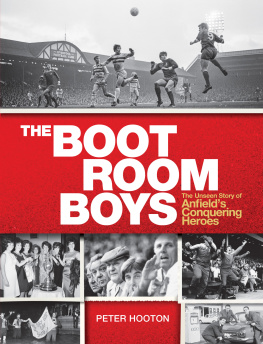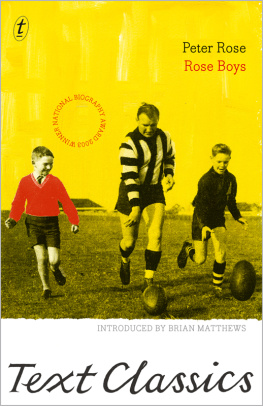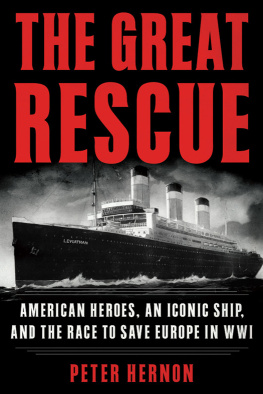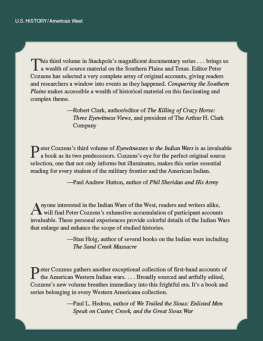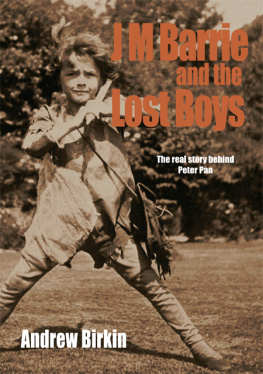Peter Hooton - The Boot Room Boys: The Unseen Story of Anfields Conquering Heroes
Here you can read online Peter Hooton - The Boot Room Boys: The Unseen Story of Anfields Conquering Heroes full text of the book (entire story) in english for free. Download pdf and epub, get meaning, cover and reviews about this ebook. year: 2018, publisher: Ebury Publishing, genre: Home and family. Description of the work, (preface) as well as reviews are available. Best literature library LitArk.com created for fans of good reading and offers a wide selection of genres:
Romance novel
Science fiction
Adventure
Detective
Science
History
Home and family
Prose
Art
Politics
Computer
Non-fiction
Religion
Business
Children
Humor
Choose a favorite category and find really read worthwhile books. Enjoy immersion in the world of imagination, feel the emotions of the characters or learn something new for yourself, make an fascinating discovery.
- Book:The Boot Room Boys: The Unseen Story of Anfields Conquering Heroes
- Author:
- Publisher:Ebury Publishing
- Genre:
- Year:2018
- Rating:5 / 5
- Favourites:Add to favourites
- Your mark:
- 100
- 1
- 2
- 3
- 4
- 5
The Boot Room Boys: The Unseen Story of Anfields Conquering Heroes: summary, description and annotation
We offer to read an annotation, description, summary or preface (depends on what the author of the book "The Boot Room Boys: The Unseen Story of Anfields Conquering Heroes" wrote himself). If you haven't found the necessary information about the book — write in the comments, we will try to find it.
Peter Hooton: author's other books
Who wrote The Boot Room Boys: The Unseen Story of Anfields Conquering Heroes? Find out the surname, the name of the author of the book and a list of all author's works by series.
The Boot Room Boys: The Unseen Story of Anfields Conquering Heroes — read online for free the complete book (whole text) full work
Below is the text of the book, divided by pages. System saving the place of the last page read, allows you to conveniently read the book "The Boot Room Boys: The Unseen Story of Anfields Conquering Heroes" online for free, without having to search again every time where you left off. Put a bookmark, and you can go to the page where you finished reading at any time.
Font size:
Interval:
Bookmark:
 Liverpool FC, 1965.
Liverpool FC, 1965.To Geraldine, Tom and Ella

Legend has it that if ever the symbolic Liver Birds fly away from their perch on top of the magnificent Royal Liver Building on Liverpools historic waterfront, the city will cease to exist. For many years Everton supporters used to mock Liverpool fans by claiming the Liver Birds would fly away before Liverpool won the FA Cup. Liverpool had been beaten FA Cup finalists in 1914 and 1950, and the club and fans were desperate to win the coveted trophy and emulate Evertons successes of 1906 and 1933. In those days before the arrival of Bill Shankly, Everton were actually regarded as the bigger club in the city, but things were soon to change. In many ways the story of the Boot Room Boys is the before and after tale of Bill Shankly and his loyal back room staff. If the post-war years and the 1950s were in monochrome, then the 1960s burst into colour. Bill Shankly even changed the kit from red shirts, white shorts and red and white socks to the distinctive all-red kit everyone knows today.
Liverpool in the 1960s would not only become the centre of world attention because of The Beatles and Merseybeat; also, remarkably, from the embarrassment of a Second Division nightmare, Shankly would revolutionise the club and turn a sleeping giant into a European force. He was able to do this by harnessing the collective endeavour and the natural enthusiasm of his trusted lieutenants. When he arrived at Anfield, he crucially decided to keep on the back room staff who were already there. He asked for loyalty and honesty and, during his reign, he certainly got those values in abundance.
Post-war Liverpool was a vibrant, bustling city of 765,000 souls, with the River Mersey and the docks its beating heart. Numerous factories employed tens of thousands of people, and for many of these people, football at the weekend was their religion. Liverpool had suffered tremendously during the dark days of the Second World War. As the second port of the Empire, it imported a third of the UKs food and goods, so became a target for Hitlers Luftwaffe. It was an attempt to disrupt trade and communications during the longest battle of the Second World War, the Battle of the Atlantic.
Rationing and hardship continued well after the war, and football was a welcome escape from the dreary post-war existence. Over 50,000 people were employed in and around the docks, and football clubs had been nurtured from the communities around them. Post-war Liverpool was a very different place to the modern city we know today. The streets around Anfield were packed with Victorian terraced houses and most fans either walked to the ground or took a tram. There were no floodlights until 1956, so games had to be played during the day invariably 3pm on a Saturday and sometimes, if there had been a particularly bad winter like the one of 1946/47, the season would continue into the summer.
 Anfield, the home of Liverpool Football Club, was surrounded by tightly packed Victorian terraced housing like Kemlyn Rd.
Anfield, the home of Liverpool Football Club, was surrounded by tightly packed Victorian terraced housing like Kemlyn Rd.Back in those days professional football was a working-class game, and the boot room boys all came from solid, working-class backgrounds it was the peoples game. Not only did the players often live in the same areas as their supporters but the players, coaches and trainers had only slightly better wages than those of the masses that went through the turnstiles. Things were beginning to change, but it would be another 30 years before players wages, fuelled by television money, would rocket beyond all recognition. After the war, under the leadership of ex-player Jimmy Guthrie, the Professional Footballers' Association threatened to strike for more money, but the players union were granted a 12 maximum wage during the playing season (10 in summer) and a minimum wage of 7 for players over 20. The players and their representatives had seen the growing popularity of the mass media and the new phenomenon that was about to sweep the nation television!
 Ronnie Moran watching television with his girlfriend Joyce in 1955.
Ronnie Moran watching television with his girlfriend Joyce in 1955.In the post-war period people who couldnt make it to the match would have to listen to the football scores on BBC Radio, huddled around the wireless, as only the very rich could afford televisions at that time. In 1948, when the Olympic Games were held in London, the BBC broadcast pictures to only about 100,000 households in the UK, while nearly 9 million held radio licences. A consumer phenomenon was just around the corner.
As salaries rose in the 1950s, people had more disposable income, so football crowds increased, while the popularity of other leisure activities also grew. Aintree would draw large crowds, and not just for the Grand National steeplechase: over 100,000 people would regularly attend the racecourse to see motor racing. Stirling Moss won the British Grand Prix there in 1955 in front of a crowd of 125,000, a record for a British sporting event at the time.
Shankly would revolutionise Liverpool FC and turn a sleeping giant into a European force.
In the 1950s televisions became the No. 1 must have household item. Significantly they became more affordable, so the number owning them rose from 1.5 million in 1951 to 9 million by 1959. My dad told me that in 1953 he travelled several miles from Anfield, where he lived, to watch the Blackpool v Bolton FA Cup Final, also known as the Stanley Matthews Final, which Blackpool won 4-3. A relative had hired a TV with a 12-inch screen that caused a lot of excitement in the family everyone wanted to see this innovative new device. It was the first televised FA Cup Final, which proved so popular that from then on Cup Finals were broadcast live, as was the final of the 1954 World Cup held in Switzerland.
There were no souvenir shops, so if you wanted to show your dedication to the team by sporting your teams colours, you would have to get someone to knit you a scarf or bobble hat, and with wool being in short supply due to rationing, it would certainly be very expensive.
The success of the boot room was arguably down to the unique bond between a group of men who simply loved the game. They were obsessed with football. It was their life. They did it for the glory of the club, and money didnt really come into it. It was all about the team, the team, and the team!
The boot room really began with the arrival of Bill Shankly in December 1959 and would last nearly 40 years until the departure of Roy Evans in 1998. It was a spiritual place and, like the Liver Birds at the Pier Head, steeped in mystery, mythology and intrigue. Graeme Souness is often blamed for the dismantling of the boot room in 1992, while in reality it was the increasing importance of television and the request for improved media facilities which brought about its physical demise. But the boot room was never really about a place; it was never about bricks and mortar. It was about an alliance of people who had a common goal, common values and the people who created the philosophy of Liverpool Football Club the people who created the Liverpool Way.
 Next page
Next pageFont size:
Interval:
Bookmark:
Similar books «The Boot Room Boys: The Unseen Story of Anfields Conquering Heroes»
Look at similar books to The Boot Room Boys: The Unseen Story of Anfields Conquering Heroes. We have selected literature similar in name and meaning in the hope of providing readers with more options to find new, interesting, not yet read works.
Discussion, reviews of the book The Boot Room Boys: The Unseen Story of Anfields Conquering Heroes and just readers' own opinions. Leave your comments, write what you think about the work, its meaning or the main characters. Specify what exactly you liked and what you didn't like, and why you think so.

